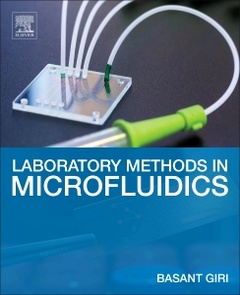Description
Laboratory Methods in Microfluidics
Author: Giri Basant
Language: English
Subject for Laboratory Methods in Microfluidics:
Keywords
Acid-base indicator; Amino acids; Amperometry; Analytical chemistry; Azo dyes; BCG assay; BSA-FITC; Bathocuproine; Beer-Lambert's law; Bioanalysis; Blood test; Bonding; Calibration curve; Chromatographic separation; Clinical chemistry; Colorimetric analysis; Colorimetric determination; Continuous phase; Coupling reaction; Diazotization; Diffusion; Diffusivity; Dispersed phase; Droplet generation; Electrochemical detection; Electrochemical paper device; Electrokinetic flow velocity; Electroosmosis; Electroosmotic mobility; Electropherogram; Electrophoresis; Electrophoretic mobility; Enzyme reaction; Filter paper; Flow synthesis; Food colors; General chemistry; Glass chip; Griess method; Immunoassay; Ionic strength; Jell-O chip; Kinetic assay; Lab-on-a-chip; Laminar flow; Limit of detection; Macromolecules; Metal pollution; Microchip electrophoresis; Microdroplets; Microfabrication; Microfluidics; Microreactors; Microsynthesis; Mixing; Multiplex device; Nanoscience; Neutralization; Ninhydrin test; Organic synthesis; PADs; Paper device; Paper microfluidics; Paper-devices; Phenonthraline method; Photolithography; Polydimethylsiloxane; Potato starch; Protein patterning; Quantitative analysis; Reynolds number; Rhodamine B; Separation resolution; Silanization; Size-dependent absorption; Standard addition; Surface modification; Surface plasmon resonance; Synthetic dyes; Tea extraction; Three-electrode system; UV-vis spectroscopy; Undergraduate lab; Urinalysis; Viscous forces; Wax dipping; Wax printing; Wet etching; µ-ELISA; µPADs; μ-TAS; μPADs
Support: Print on demand
Description
/li>Contents
/li>Readership
/li>Biography
/li>Comment
/li>
Laboratory Methods in Microfluidics features a range of lab methods and techniques necessary to fully understand microfluidic technology applications. Microfluidics deals with the manipulation of small volumes of fluids at sub-millimeter scale domain channels. This exciting new field is becoming an increasingly popular subject both for research and education in various disciplines of science, including chemistry, chemical engineering and environmental science.
The unique properties of microfluidic technologies, such as rapid sample processing and precise control of fluids in assay have made them attractive candidates to replace traditional experimental approaches.
Practical for students, instructors, and researchers, this book provides a much-needed, comprehensive new laboratory reference in this rapidly growing and exciting new field of research.
Introduction of microfluidics Experiment 1. Fabrication of a glass microfluidic device Experiment 2. Fabrication of paper microfluidic device for blood plasma separation Experiment 3. Fabrication and testing of PDMS microchip Experiment 4. Electrophoretic separation in a microchannel Experiment 5. Determination of electroosmotic flow in a straight glass microchannel Experiment 6. A simple experiment for the study of droplet microfluidics Experiment 7. Laminar flow and diffusion in microchannel Experiment 8. Beer’s law using a smartphone Experiment 9. Acid-base titrations in paper analytical device Experiment 10. Simultaneous determination of glucose and protein in urine sample using paper microfluidics Experiment 11. Quantitative determination of total amino acids using paper microfluidics and a smartphone Experiment 12. Determination of nitrite ions using paper analytical device Experiment 13. Colorimetric determination of multiple metal ions on uPAD Experiment 14. Analysis of a mixture of paracetamol and 4-aminophenol in a paper-based microfluidic device Experiment 15. Synthesis of gold nanoparticles on microchip Experiment 16. Flow synthesis of organic dye on microchip Experiment 17. Enzyme-linked immunosorbent assay on a glass microfluidic device Experiment 18. Probing single cell mechanics on a microfluidic platform Experiment 19. Microfluidic device for observing algae phototaxis Experiment 20. A lab-on-a-chip experiment for protein immobilization
Analytical Chemists, Physical Chemists, Chemical Engineers, and Biochemists comprise the primary audience. Secondary audience includes students at the upper undergraduate and graduate levels taking related laboratory coursework
- Provides a number of detailed methods and instructions for experiments in microfluidics
- Features an appendix that highlights several standard laboratory techniques, including reagent preparation plus a list of materials vendors for quick reference
- Authored by a microfluidics expert with nearly a decade of research on the subject



